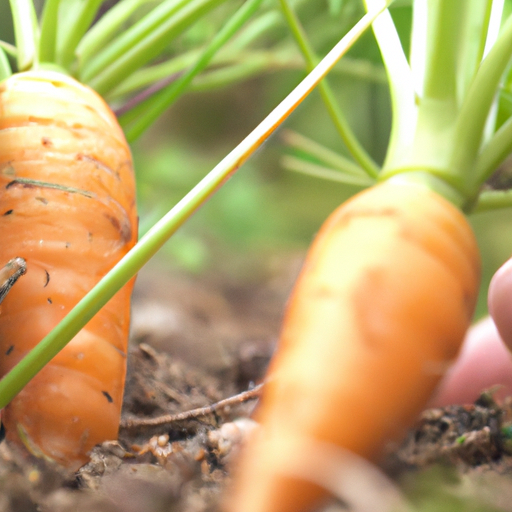Table of Contents
Step-by-Step Guide to Planting Carrots in Your Garden

Wondering how to grow carrots in your garden? It’s easy and carrots are a great addition to any garden! They’re easy to grow and taste better than store-bought produce. Here’s a step-by-step guide to help you get started.
Step 1: Choose the Right Spot
Carrots need full sun and well-drained soil. Pick a spot in your garden that gets at least 6 hours of direct sunlight each day.
Step 2: Prepare the Soil
Carrots need loose, sandy soil to grow. Use a garden fork to loosen the soil and remove any rocks or debris.
Step 3: Plant the Seeds
Sow the carrot seeds about 1/4 inch deep and 1 inch apart. Cover the seeds with soil and lightly water them.
Step 4: Thin the Seedlings
Once the seedlings have grown to about 2 inches tall, thin them out so that they are 4 inches apart.
Step 5: Water Regularly
Carrots need to be kept moist, so water them regularly. Aim for about 1 inch of water per week.
Step 6: Fertilize
Fertilize your carrots every few weeks with a balanced fertilizer.
Step 7: Harvest
Harvest your carrots when they are about 2 inches in diameter. Pull them gently from the ground and enjoy!
Congratulations! You’ve just planted carrots in your garden. With a little bit of care and attention, you’ll have a delicious crop of carrots in no time.
Tips for Preparing Soil for Growing Carrots
1. Start with a well-draining soil. Carrots need a soil that is light and fluffy, so it’s important to make sure your soil is well-draining. If your soil is too heavy, you can add some sand or compost to help improve drainage.
2. Add organic matter. Adding organic matter to your soil will help improve its structure and provide essential nutrients for your carrots. Compost, manure, and peat moss are all great options.
3. Test your soil’s pH. Carrots prefer a slightly acidic soil with a pH between 6.0 and 6.8. If your soil is too alkaline, you can add sulfur to lower the pH.
4. Till the soil. Tilling the soil will help break up any large clumps and create a more even surface for planting.
5. Fertilize. Carrots need a steady supply of nutrients, so it’s important to fertilize your soil before planting. A balanced fertilizer like 10-10-10 is a good choice.
6. Plant your carrots. Once your soil is prepared, you can plant your carrots. Make sure to space them out evenly and cover them with soil. Water them well and keep the soil moist.
How to Water and Fertilize Carrots for Maximum Yield
Growing carrots is a great way to add a nutritious and delicious vegetable to your garden. To get the most out of your carrot crop, it’s important to water and fertilize them properly. Here’s how to do it for maximum yield.
Watering Carrots
Carrots need about an inch of water per week, either from rainfall or from your watering can. If you’re using a watering can, water the soil around the carrots deeply and evenly. Make sure the water reaches the roots, which can be up to two feet deep.
Fertilizing Carrots
Carrots need a balanced fertilizer with a ratio of 10-10-10 or 12-12-12. Apply the fertilizer when the carrots are about two inches tall, and then again when they are four inches tall. Spread the fertilizer evenly around the carrots, but keep it away from the stems.
Harvesting Carrots
Harvest your carrots when they reach the desired size. Pull them gently from the ground, and enjoy the fruits of your labor!
Common Pests and Diseases to Look Out for When Growing Carrots
Growing carrots is a great way to add some delicious, nutritious vegetables to your garden. However, like any other crop, carrots can be affected by pests and diseases. Here are some of the most common pests and diseases to look out for when growing carrots:
1. Carrot Rust Fly: This is a small fly that lays its eggs in the soil near the carrot plants. The larvae then feed on the roots of the carrots, causing them to become stunted and deformed. To prevent carrot rust fly, use row covers or insect netting to keep the flies away from your carrots.
2. Carrot Weevil: This is a small beetle that feeds on the leaves of the carrot plants. The larvae then burrow into the roots of the carrots, causing them to become misshapen and discolored. To prevent carrot weevil, use row covers or insect netting to keep the beetles away from your carrots.
3. Carrot Root Maggots: These are small white maggots that feed on the roots of the carrots. They can cause the carrots to become stunted and deformed. To prevent carrot root maggots, use row covers or insect netting to keep the maggots away from your carrots.
4. Alternaria Leaf Blight: This is a fungal disease that causes dark spots on the leaves of the carrot plants. To prevent Alternaria leaf blight, make sure to water your carrots at the base of the plant and not on the leaves.
5. Fusarium Wilt: This is a fungal disease that causes the leaves of the carrot plants to turn yellow and wilt. To prevent Fusarium wilt, make sure to rotate your crops and avoid planting carrots in the same spot year after year.
By following these tips, you can help ensure that your carrots stay healthy and free from pests and diseases. Do you have any growing tips? Be sure to share them in the comments!


